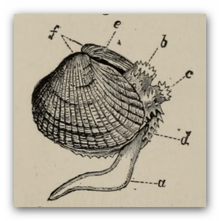Cerastoderma edule
| Cerastoderma edule | |
|---|---|
.jpg) | |
| Scientific classification | |
| Kingdom: | Animalia |
| Phylum: | Mollusca |
| Class: | Bivalvia |
| Order: | Veneroida |
| Family: | Cardiidae |
| Genus: | Cerastoderma |
| Species: | C. edule |
| Binomial name | |
| Cerastoderma edule (Linnaeus, 1758) [1] | |
| Synonyms | |
| |
Cerastoderma edule, commonly known as the common cockle, is a species of edible saltwater clam, a marine bivalve mollusc in the family Cardiidae, the cockles.
This species is found in coastal areas of the eastern Atlantic Ocean. It is widely distributed from Norway to the coast of west Africa.

The common cockle is one of the most abundant species of molluscs in tidal flats in the bays and estuaries of Europe. It is an important species for the fishing industry, and it plays a major role as a source of food for crustaceans, fish, and wading birds. It is commercially fished in the United Kingdom, Ireland and France by suction dredge and hand raking. Previously the greatest catch was from the Netherlands, but now fisheries restrictions have been put in place due to environmental concerns. It is also used in aquaculture; farming of cockles is ongoing in the UK, the Netherlands and Portugal, however information about this enterprise is limited. It moves by spitting water.
This cockle is cooked and eaten in several countries (including the United Kingdom, France, Germany, Ireland, Japan, Portugal and Spain). Probably a significant food source in hunter-gatherer societies of prehistoric Europe, the remains of shell-imprints have been found, see Archeological record below.
Archeological record
Cardial Ware is a name attributed to Neolithic pottery from maritime cultures that colonized the Mediterranean littoral c. 6000 – 5,500 B.C.

The clay is imprinted with fine decorations, repetitions of the distinct curved ridges, undulating lines and/or edges characteristic to the cockle shell, a natural resource of coastal waters.
References
- ↑ Jan Johan ter Poorten & Serge Gofas (2011). "Cerastoderma edule (Linnaeus, 1758)". World Register of Marine Species. Retrieved April 20, 2011.
